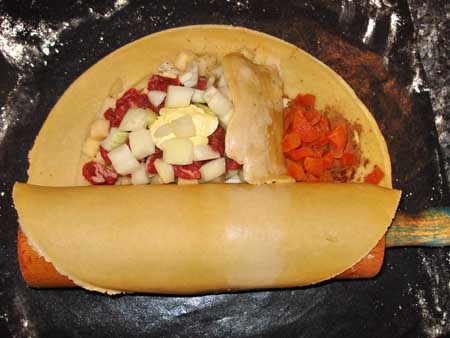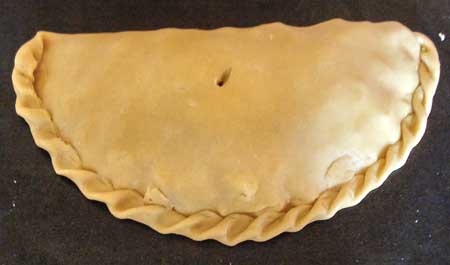The Cornish Pasty |
The traditional Cornish pasty with a dessert at one end
After deliberation and practice, The Cornish Pasty brings you
something special - like my Mother used to make!
There are several mentions on the internet about these pasties, variously known as .....
Until recently, the making of these pasties seems to have fallen into abeyance. Recipes are hard to find. It may be because when these pasties were made for miners - and I had a few calls about this after my short "spot" about them on Radio Cornwall - the people involved were rarely literate let alone in the business of writing recipe books. They were too busy scratching a living and pasty recipes were handed down the generations by word of mouth.
Pasty-making is a mix of art and science and the old people would make them using traditional ingredients but when times were hard, they used what they had - if there was no meat then you had a tiddy oggy. The recipe below is for traditional miners' pasties and the making of them is based partly on The Pasty Recipe, a family poem.
| 1� lbs plain flour (680 g) | Sift to add air to the mixture. |
| 1 lb Stork margarine (450 g) | Healthier than lard, and possibly better tasting. |
| � pint (precise!) cold water (470 ml) | I aim to have a small amount left after making the dough, |
| � a level teaspoon of salt | Low-sodium for me - add it to the water. |
| 1 tsp of sugar | If you want a sweeter taste to the pastry. |
Other ingredients
Main course filling - meat & vegetables
| Swede/yellow turnip (American: rutabaga) |
Prepare this first, cut a slice about �-inch (5 mm) thick for each
pasty, this is a hard root vegetable needing a sharp knife - take
care Peel the edge of the slice - a potato peeler is good. Dice it - i.e. cut into �-inch (5 mm) cubes. |
|
Skirt beef � lb (340 g) or chuck steak as an alternative |
Trim any fat etc. and cut into pieces about �-inch (1 cm) cube and cover. |
| Onions - one large for each large pasty | Peel and dice or cut into thick cubes and cover. |
| Potatoes, one big one for each large pasty |
Peel and cut into slivers or small slices or dice - your choice! Do this last because it will blacken if left exposed for too long - can be left under water to keep good if necessary. |
| Salt | Again, low-sodium for me. |
| Ground pepper |
It is said white pepper for taste and
black pepper for scent, best when freshly ground. |
| Butter or substitute |
A knob of butter on the meat keeps the pasty moist after cooking. No butter gives a dry pasty, too much gives a leaking pasty. I use as much as for a slice of bread = a moderately heaped tsp? |
|
"Afters" - dessert filling |
|
| Cooking apple |
�-inch (1 cm) thick slice per pasty, cored
and peeled.
You have to play with the shape for yourself, sometimes using bits! |
| Cinnamon - good pinch | To taste - I fill the tip of a small teaspoon, added to the apple. |
| Brown sugar | To cover the apple. |
| Sultanas, cherries, dried fig, apricot or date. |
Sultanas - small handful on top of the apple, other fruits are chopped into approximately
sultana-sized pieces. Remove any sultana stalks and de-stone cherries. |

The butter is important, without it the pasty will be dry. I use enough on a knife to well-butter a slice of bread. Too much, and the pasty will be wet.

This pasty had chopped dried apricot instead of sultanas

The pasty before baking.
Click on the image above to see a movie about crimping.
Leftovers
If there are any, these can often make a pasty pie, on a plate, covered with pastry - 'tis not the Cornish way to waste them!
Baking the pasties
The oven should be preheated.
200�C, 400�F or Gas Regulo 6 for 30 minutes
because the pastry needs to be cooked quickly, then turn down to .....
160�C, 325�F or Gas Regulo 3 for 30 minutes
to finish cooking the meat etc. Perhaps less time for non-meat pasties.
After baking, the pasties should be put on a rack to cool.

The steam hole is at the meat and veg. end,
the personal initial is at the sweet end.
Enjoy!
And if you get this far, you deserve this joke, reputedly from Jethro, the Cornish comedian: The original pasty actually had three compartments - there was a very small one at the end to hold your After Eight mint.
All courtesy of The Cornish Pasty webmaster, pasty-maker extraordinaire ................ if Father could see me now!
